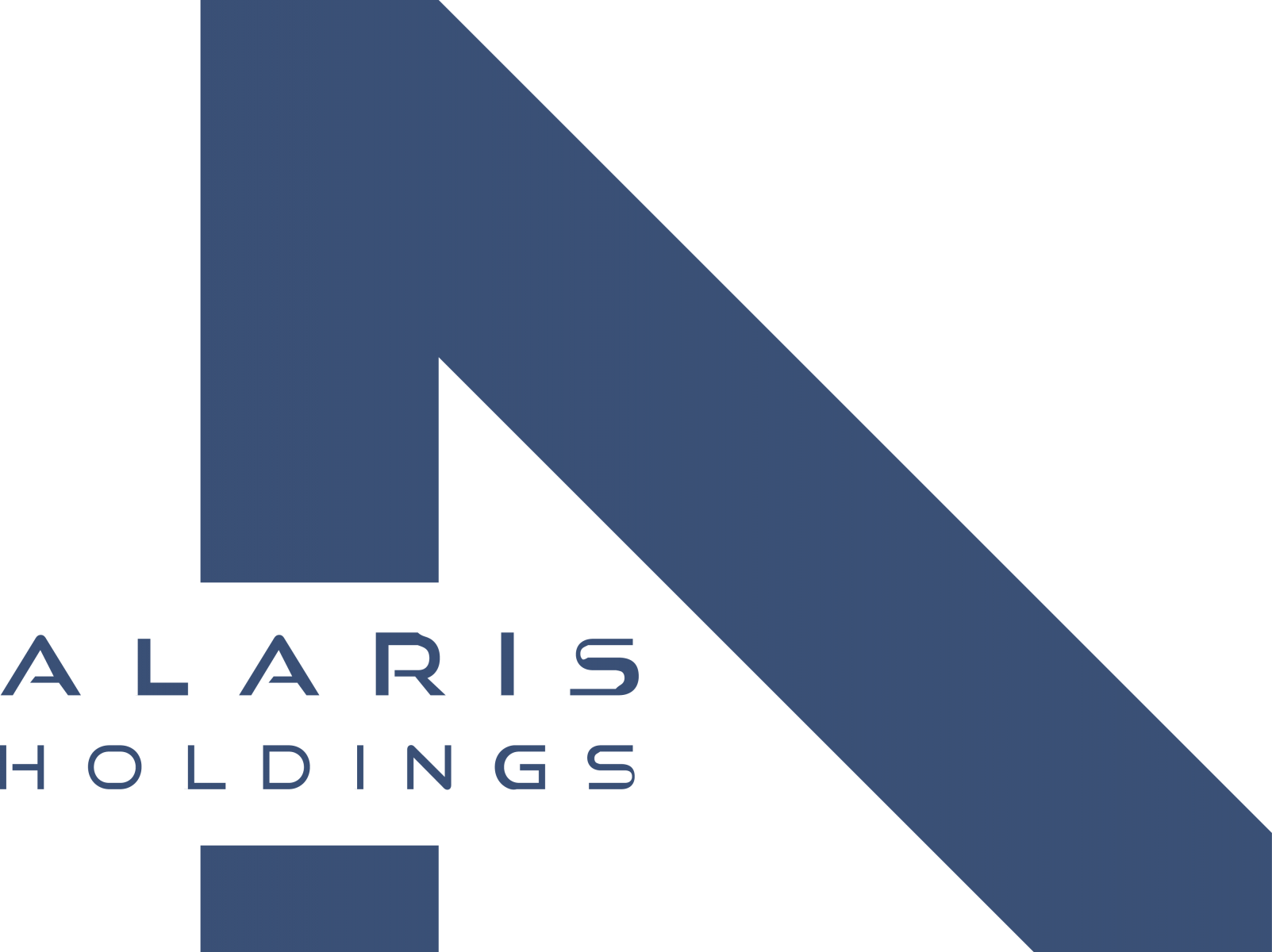Home / QH40A
Referenzen
High stablility crystal oven based on the principle of zero temperature gradient
High Stability Crystal Oven based on the Principle of Zero Temperature Gradient
By Rex Moncur, VK7MO
Karlquist et al1of Hewlett Packard, discussed the theory of Zero Temperature Gradient crystal ovens that can produce improvements in frequency stability with temperature by a factor of 20 or more compared to conventional oven oscillators. The techniques used by Karlquist lead one to think about what might be possible with amateur home brew construction. This has led to the concept of a modified Zero Temperature Gradient oven based on a conventional oven in conjunction with six low-cost DB6NT precision crystal heaters that actively maintain a zero temperature gradient within a diecast box. The modified Zero Temperature Gradient Oven has a stability* of better than 1 Hz at 1296 MHz, or one part in 10^9th.
* Stability measured in the home environment over 24 hours with ambient temperature variations of 5 degrees.
By Rex Moncur, VK7MO
Karlquist et al1of Hewlett Packard, discussed the theory of Zero Temperature Gradient crystal ovens that can produce improvements in frequency stability with temperature by a factor of 20 or more compared to conventional oven oscillators. The techniques used by Karlquist lead one to think about what might be possible with amateur home brew construction. This has led to the concept of a modified Zero Temperature Gradient oven based on a conventional oven in conjunction with six low-cost DB6NT precision crystal heaters that actively maintain a zero temperature gradient within a diecast box. The modified Zero Temperature Gradient Oven has a stability* of better than 1 Hz at 1296 MHz, or one part in 10^9th.
* Stability measured in the home environment over 24 hours with ambient temperature variations of 5 degrees.
Installation of a QH 40 A crystal heater into a standard JRC JST-245 TCVR
Here are some photos of my installation of the QH40A crystal heater into a standard JRC JST-245 tcvr. The 12 V DC and ground supply are right next to the std oscillator crystal and DC voltage is present when tcvr is switched on. I do have a TXCO for the JST-245 [not installed] but instead I fitted your QH40A, I did not need to remove the synthesiser pcb to enable me to fit the QH40A , it can be fitted without removal of any parts or pcbs. I know some amateurs use the JST-245 as a transverter driver for 2m contesting and EME. I use mine on 50mhz for EME, this morning at 0430z I worked ZL3TY via EME on 6m using JT65A mode, with the JST-245 as my transmitter.
QRA RE57OM > IO91DO = 18,862KM .
Thanks.
Ian Williams M0BCG
.JPG)
.JPG)
.JPG)
.JPG)
QRA RE57OM > IO91DO = 18,862KM .
Thanks.
Ian Williams M0BCG
.JPG)
.JPG)
.JPG)
.JPG)
Installation of a QH 40 A crystal heater into a Icom IC-746
Hello,
Here are the photos I made for installing properly the QH40A in my Icom
IC-746, using an internal 8V line given by a 7808 regulator in the
tranceiver as supply for the QH40A.
For better thermal stability I used silicon compound between the
reference XTAL and the heater, and I placed cotton arround the
oscillator as showned on the photos..
The mesure I did with my Marconni 2955 (OCXO) Radiocom test set and
Racal Danal 1991 (TCXO) frequency meter give 50Hz drift on 145.000 MHz
when transmitting continuously 5 minutes after 4 hours standing on
receiving (to get the tranceiver warm up).
This give frequency stability better than +/- 0.2 ppm ... and better
than the Icom CR-282 TCXO solution wich is +/- 0.5 ppm.
Best reguards, Gerald - F4AVW.
.jpg)
.jpg)
.jpg)
.jpg)
.jpg)
Here are the photos I made for installing properly the QH40A in my Icom
IC-746, using an internal 8V line given by a 7808 regulator in the
tranceiver as supply for the QH40A.
For better thermal stability I used silicon compound between the
reference XTAL and the heater, and I placed cotton arround the
oscillator as showned on the photos..
The mesure I did with my Marconni 2955 (OCXO) Radiocom test set and
Racal Danal 1991 (TCXO) frequency meter give 50Hz drift on 145.000 MHz
when transmitting continuously 5 minutes after 4 hours standing on
receiving (to get the tranceiver warm up).
This give frequency stability better than +/- 0.2 ppm ... and better
than the Icom CR-282 TCXO solution wich is +/- 0.5 ppm.
Best reguards, Gerald - F4AVW.
.jpg)
.jpg)
.jpg)
.jpg)
.jpg)
QH40A Mod for FT-847
QH40A Mod for FT-847
Despite my fan modifications, I was not quite satisfied with the frequency stability on my FT-847, when running high-duty-cycle modes, it would drift up to 3-400Hz on 144MHz after 15-30mins of hard (WSJT, full power) use!
I found a mention of the QH40A Crystal Heater from DB6NT on mods.dk, more information on: http://www.kuhne-electronic.de/english/special/crystalheater.htm , which you place against the appropriate X-tal, to heat it to 40.8° C ±0.1° C
The total price, packaging and postage included (i.e. inside the EU), was € 14.
The heater unit is placed against the Reference X-tal, X1001, and connected to ground and +8-12V

Here the X-tal heater has been placed against X1001 and the wires attached

Jarl, OZ9MO has wrapped a piece of Copper foil around the Crystal before attaching the Crystal heater, in order to improve distribution of the heat to both sides of the crystal. Recommended!
http://www.frenning.dk/OZ1PIF_HOMEPAGE/QH40A.htm
Despite my fan modifications, I was not quite satisfied with the frequency stability on my FT-847, when running high-duty-cycle modes, it would drift up to 3-400Hz on 144MHz after 15-30mins of hard (WSJT, full power) use!
I found a mention of the QH40A Crystal Heater from DB6NT on mods.dk, more information on: http://www.kuhne-electronic.de/english/special/crystalheater.htm , which you place against the appropriate X-tal, to heat it to 40.8° C ±0.1° C
The total price, packaging and postage included (i.e. inside the EU), was € 14.
The heater unit is placed against the Reference X-tal, X1001, and connected to ground and +8-12V

Here the X-tal heater has been placed against X1001 and the wires attached

Jarl, OZ9MO has wrapped a piece of Copper foil around the Crystal before attaching the Crystal heater, in order to improve distribution of the heat to both sides of the crystal. Recommended!
http://www.frenning.dk/OZ1PIF_HOMEPAGE/QH40A.htm
Installation of the QH 40 A into an Icom IC-R71E HF Receiver
Installation of a QH 40 A crystal heater into an Icom IC-R71E HF Receiver
Following, few details of installation of the QH40A into an Icom IC-R71E HF Receiver.
Given that:
- As there’s no 8 - 12VDC voltages points around, a TA78L10 10 VDC/100 mA Positive Voltage Regulator is needed to drop 13.7 VDC available to 10 VDC, avoiding possible damages to the QH-40 A
- IMPORTANT NOTE: A drop resistor is not reccommended, in order o avoid voltage variations !!!
- I spread some silicon paste on the QH40A and the Crystal Face, to allow heat to be better transferred to the crystal enclosure surface.
Procedure for the mod:
- Locate the PLL Board on the left side of the receiver
- There’s an area on the PLL Board where the main PLL crystal X1 is located. In that area you could install the original Icom CR-64 TCXO option. The drawback is that that option is no more available, and used, really expensive.
- It’s necessary to remove the PLL card carefully removing wire harness (socketed) and two grey coaxes, with slide in plugs. There are six screws holding the board to the cabinet.
- One yellow wire goes to the Main Unit, and it’s single pin socketed. Be careful to unplug it.
- There’s a wire jumper to solder in order to bring 13.8 VDC on the trace with the purpose of powering the CR-64 (in our case it’s ok for powering the Crystal Heater QH40A). Pls refer to the User’s Manual and/or to the b/w picture attached herebelow.
- Cut with a cutter the the trace powering the CR64 Option, leaving a space of 1 mm, then drill 1 mm hole each side of the trace, possibly close to soldering isles.
- Drill a 1 mm hole in the GND area wherever you’re confortable with the shape of the Regulator pins.
- Mount a TA78L010AP Positive 100mA Voltage Regulator following this pinout:
- PIN1 (Input) goes in the hole corresponding to the Isle where Added Wire Jumper arrives
- PIN3 (GND) goes to the GND hole
- PIN2 (Output) goes in the hole corresponding to the Isle where CR64 would be powered ( in our case where a red wire goes to the left soldering isle of the QH40A )
- Re-adjust Frequency Calibrator Trim (it is located on the bottom of the receiver)
- (do that after 15’ of Burn-In)
Note: Measurements of the DC Power out of the regulator was 9.92 VDC very stable, and the Crystal Quartz Frequency went stable just after 3 minutes.
Enjoy your mod !
IW2FMK
Roberto – Milano
Original User’s Manual Jumperinstructions for powering the CR-64 TCXO
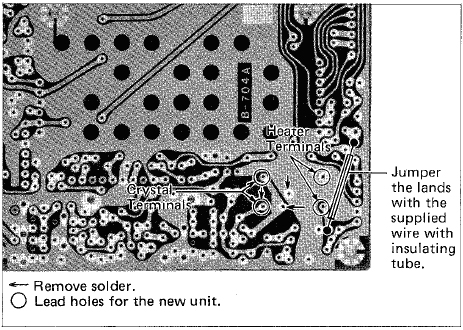
PLL Board layout and componentpositioning
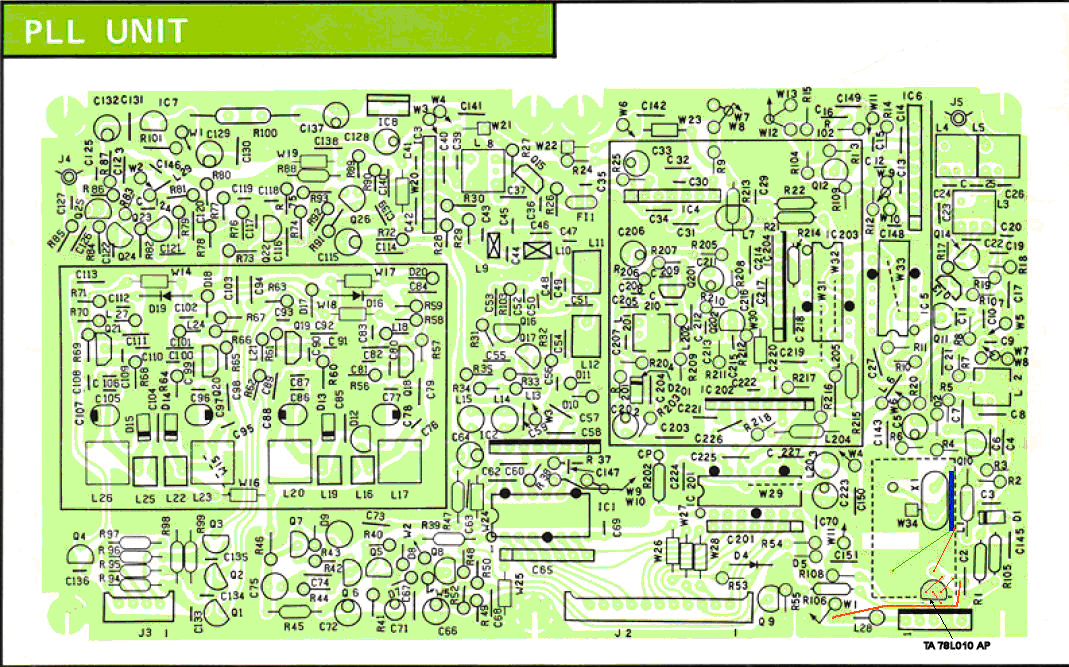
PLL Crystal / Crystal heaterEnlargment
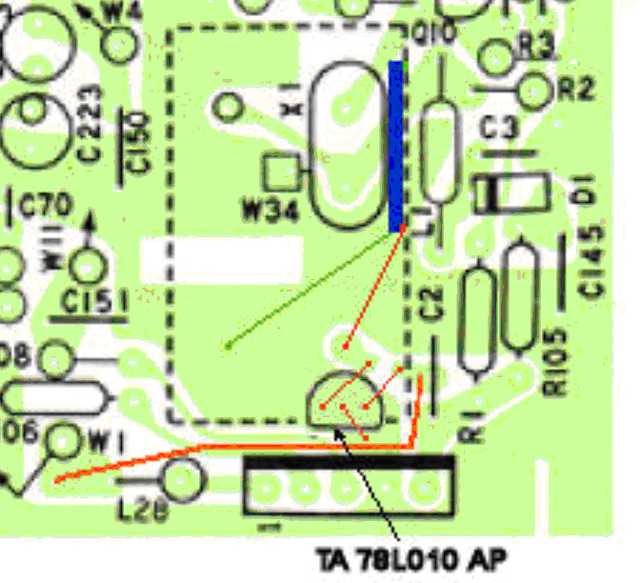
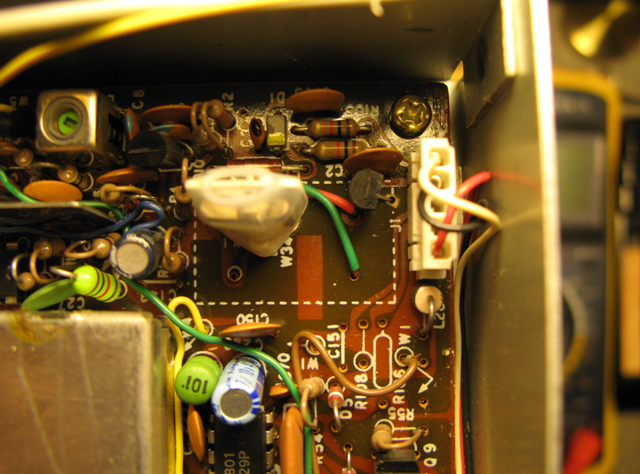
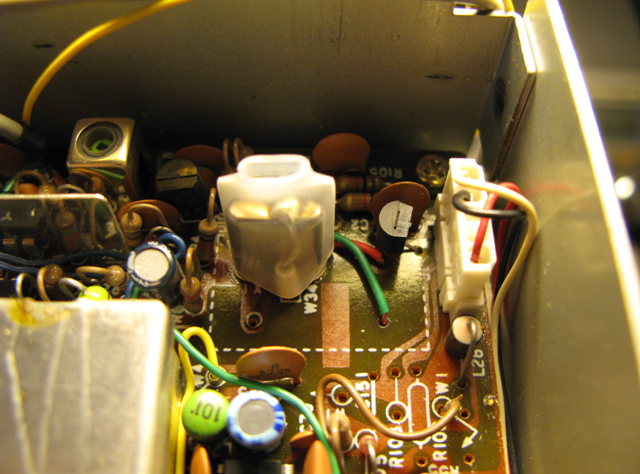
Umbau des LT2S Transverters auf Betrieb mit Quarzheizer QH40A
QH 40 A - Umbau des LT2S Transverters auf Betrieb mit Quarzheizer
A: Ausgangszustand
B: Quarzheizer QH40A eingebaut, sonst nicht verändert. Quarzheizer-Versorgungsspannung mit 12V Low-Drop Voltage-Regulator stabilisiert. Temperaturdrift TD1 ermittelt (hier ca. 250 Hz).
C: Original C2 (68 pF/N750) durch NP0-Kondensator ersetzt. Temperaturdrift TD2 ermittelt (hier ca. 150 Hz). Aus der Differenz TD1-TD2 die Kombination C1(N750)/C3(NP0) ausgerechnet.
D: Endzustand: Zu C1 = 8.2 pF/N750 wurde C3 = 3.9 pF/NP0 parallel gelötet. Kleinen Lüfter und Kühlkörper auf die Transverter-Box im LT2S eingebaut, damit Schaltungs-Umgebungs-Temperatur nicht über 40°C (QH40A- Regel-Temperatur) steigt.
Diese Bauteile-Werte wurden beim LT2S des Verfassers als optimal ermittelt und können höchstens als Richt- bzw. Start-Werte für eigene Versuche angesehen werden. Die Frequenz-Messungen wurden im RX-Betrieb über die hochstabile Bake DF0ANN auf 144,465000 MHz mit Hilfe der Spectran-Software durchgeführt. Die beim Verfasser erreichte Frequenz-Stabilität nach ca. 2 min. Einlaufzeit (sowohl im Lang- als auch Kurzzeit-Betrieb) ist ausreichend für JT65B EME-QSOs.
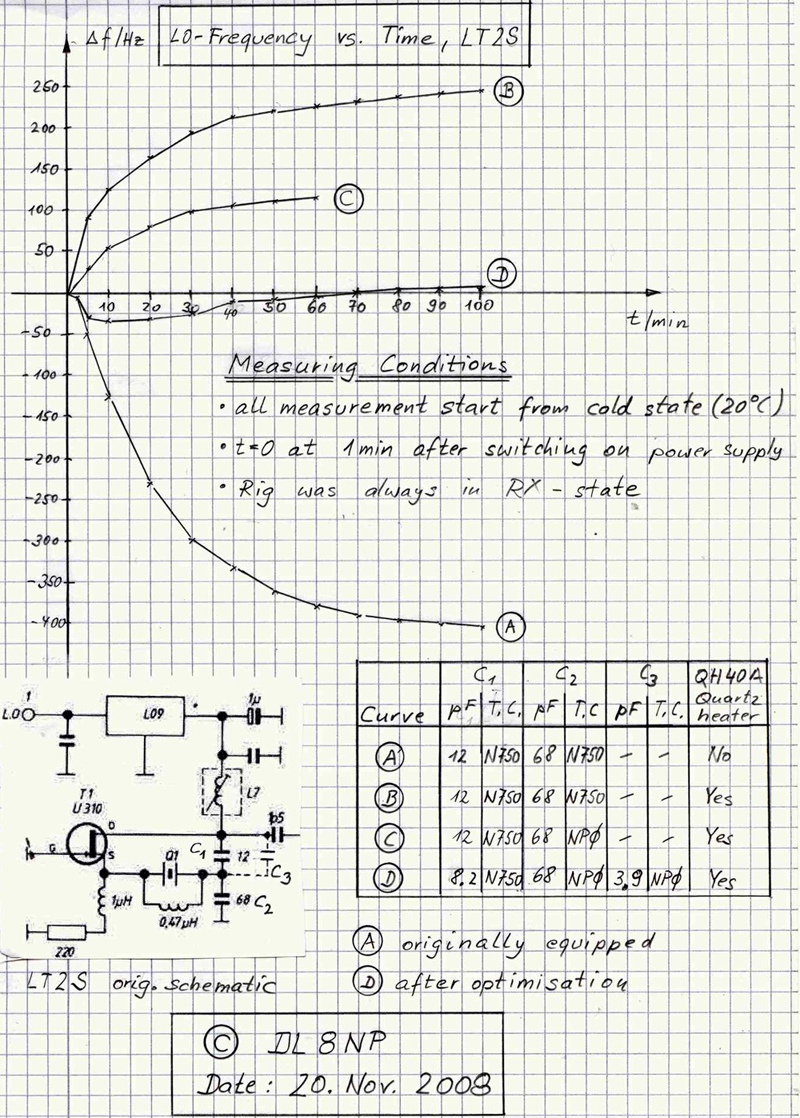
A: Ausgangszustand
B: Quarzheizer QH40A eingebaut, sonst nicht verändert. Quarzheizer-Versorgungsspannung mit 12V Low-Drop Voltage-Regulator stabilisiert. Temperaturdrift TD1 ermittelt (hier ca. 250 Hz).
C: Original C2 (68 pF/N750) durch NP0-Kondensator ersetzt. Temperaturdrift TD2 ermittelt (hier ca. 150 Hz). Aus der Differenz TD1-TD2 die Kombination C1(N750)/C3(NP0) ausgerechnet.
D: Endzustand: Zu C1 = 8.2 pF/N750 wurde C3 = 3.9 pF/NP0 parallel gelötet. Kleinen Lüfter und Kühlkörper auf die Transverter-Box im LT2S eingebaut, damit Schaltungs-Umgebungs-Temperatur nicht über 40°C (QH40A- Regel-Temperatur) steigt.
Diese Bauteile-Werte wurden beim LT2S des Verfassers als optimal ermittelt und können höchstens als Richt- bzw. Start-Werte für eigene Versuche angesehen werden. Die Frequenz-Messungen wurden im RX-Betrieb über die hochstabile Bake DF0ANN auf 144,465000 MHz mit Hilfe der Spectran-Software durchgeführt. Die beim Verfasser erreichte Frequenz-Stabilität nach ca. 2 min. Einlaufzeit (sowohl im Lang- als auch Kurzzeit-Betrieb) ist ausreichend für JT65B EME-QSOs.




